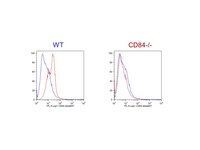MABF929 Sigma-AldrichAnti-CD84/Slamf5 Antibody, clone 1D3
This rat monoclonal Anti-CD84/Slamf5, clone 1D3 Antibody, Cat. No. MABF929 is validated for use in Flow Cytometry for the detection of CD84/Slamf5.
More>> This rat monoclonal Anti-CD84/Slamf5, clone 1D3 Antibody, Cat. No. MABF929 is validated for use in Flow Cytometry for the detection of CD84/Slamf5. Less<<Recommended Products
Overview
| Replacement Information |
|---|
Key Specifications Table
| Species Reactivity | Key Applications | Host | Format | Antibody Type |
|---|---|---|---|---|
| M | FC | R | Purified | Monoclonal Antibody |
| References |
|---|
| Product Information | |
|---|---|
| Format | Purified |
| Presentation | Purified rat IgG1 in buffer containing 0.1 M Tris-Glycine (pH 7.4), 150 mM NaCl with 0.05% sodium azide |
| Quality Level | MQ100 |
| Physicochemical Information |
|---|
| Dimensions |
|---|
| Materials Information |
|---|
| Toxicological Information |
|---|
| Safety Information according to GHS |
|---|
| Safety Information |
|---|
| Storage and Shipping Information | |
|---|---|
| Storage Conditions | Stable for 1 year at 2-8°C from date of receipt. |
| Packaging Information | |
|---|---|
| Material Size | 100 μg |
| Transport Information |
|---|
| Supplemental Information |
|---|
| Specifications |
|---|
| Global Trade Item Number | |
|---|---|
| Catalog Number | GTIN |
| MABF929 | 04054839056246 |
Documentation
Anti-CD84/Slamf5 Antibody, clone 1D3 Certificates of Analysis
| Title | Lot Number |
|---|---|
| Anti-CD84/Slamf5, clone 1D3 -Q2737507 | Q2737507 |















